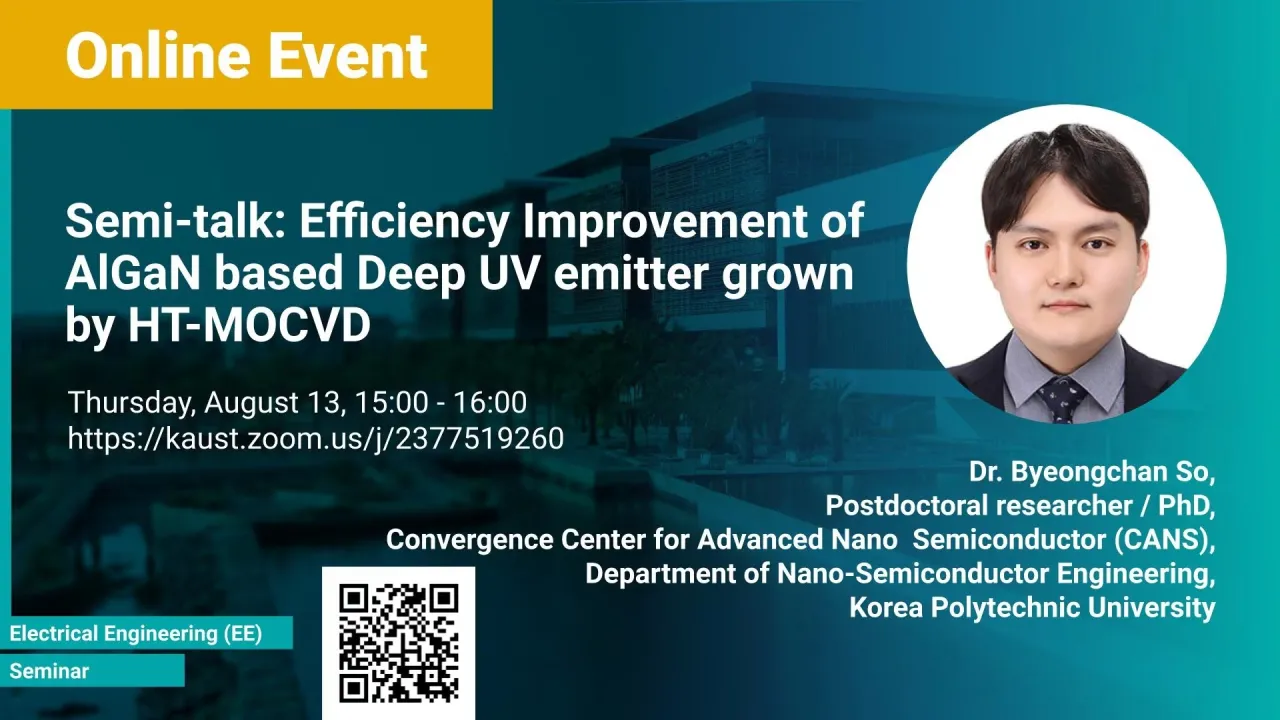
Semi-talk: Efficiency Improvement of AlGaN based Deep UV emitter grown by HT-MOCVD
- Dr. Byeongchan So, Postdoctoral researcher / Ph.D. Department of Nano-Semiconductor Engineering, Korea Polytechnic University
KAUST
In this seminar, the approaches for improving the efficiency of AlGaN based DUV emitters will be presented. The high-temperature metal organic chemical vapor deposition system has been used to grow high-quality AlGaN based epi-layers and nanostructure on the sapphire substrate.
Overview
Abstract
Nowadays, the pure air/water/food has attracted considerable attention as increasing needs for the quality of life. Especially these days the world is facing a terrible epidemic related to the coronavirus (COVID-19), which spreads from person-to-person, mostly through respiratory droplets that occur when infected individual sneezes or coughs in air. Deep ultraviolet light emitting diodes (DUV LEDs) with the emission wavelength in the range of 200-280nm has been demonstrated to be promising for applications in sterilization and environmental purification by disinfecting viruses. Because AlxGa1-xN semiconductor material has ultra-wide and direct band gaps between 3.4 and 6.2 eV, Al-rich AlGaN alloys are the prime candidate for the realization of DUV LEDs for disinfection and purification [1]. Nevertheless, there are still a few issues that need to resolve for achieving the commercialization of the DUV LED. The typical external quantum efficiency (EQE) of AlGaN based DUV LEDs is considerably lower than that of InGaN based blue LEDs. This is the reason why the commercialization of DUV LEDs is delayed. Therefore, the enhancement of internal quantum efficiency (IQE), current injection efficiency (CIE), and light extraction efficiency (LEE) is essential for realizing high EQE DUV LEDs.
In this seminar, the approaches for improving the efficiency of AlGaN based DUV emitters will be presented [2-5]. The high-temperature metal organic chemical vapor deposition system has been used to grow high-quality AlGaN based epi-layers and nanostructure on the sapphire substrate.
References
[1] H. Hirayama, N. Maeda, S. Fujikawa, S. Toyoda, and N. Kamata, Jpn. J. Appl. Phys., 53, 100209 (2014)
[2] B. So, J. Kim, T. Kwak, T. Kim, J. Lee, U. Choi, and O. Nam, RSC Adv., 8, 35528 (2018)
[3] B. So, J. Kim, E. Shin, T. Kwak, T. Kim, and O. Nam, Phys. Status Solidi A, 215, 1700677 (2018)
[4] B. So, C. Choen, J. Lee, J. Lee, T. Kwak, U. Choi, J. D. Song, J. Chang, and Okhyun Nam, Thin Solid Film 708, 1381032 (2020)
[5] J. Kim, U. Choi, J. Pyeon, B. So, and O. Nam, Sci. Rep., 8, 935 (2018)
Brief Biography
Byeongchan So received his Ph.D. degree in engineering from Korea Polytechnic University, South Korea in 2019. Now he has been trained as a postdoctoral researcher at Professor Okhyun Nam’s lab, the Convergence Center for Advanced Nano Semiconductor in Korea Polytechnic University. His research field is the epitaxial growth for Nitride wide bandgap semiconductor using MOCVD. He has been particularly involved in the study of AlN/AlGaN based material with high-quality epi-layer and nanostructures for high efficiency deep UV optoelectronic devices. Additionally, he has been involved in the study of the epitaxial growth of AlN/GaN based HEMT for electronic device applications. He has authored 24 publications and given presentations at national and international conferences.
Byeongchan So is now focusing on the epitaxial growth of AlN/AlGaN/GaN materials on Diamond substrate using MOCVD and the demonstration of high efficiency deep UV optoelectronic devices.
